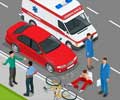A new report has revealed that U.S. emergency medical care is stretched to its limit and ill prepared to handle disasters.
A new report has revealed that U.S. emergency medical care is stretched to its limit and ill prepared to handle disasters. The need of the hour is to expand capacity, address special needs of children and improve coordination before and after patients arrive.
A series of three reports from the National Academies of Sciences' Institute of Medicine (IOM) have pointed out that overcrowded hospital emergency departments have reached a "breaking point" and are diverting ambulances to less-pressed facilities which has only increased the time and potential risks to the plight of a patient.When a panel of experts surveyed the condition of hospital-based ER care, pediatric emergency care and out-of-hospital emergency medical services it was found that patients often have to wait hours and sometimes even days to get a hospital bed, ambulances are turned away from full ERs about 500,000 times a year. According to the report disjointed medical first-response systems only add to the burden and the practice of boarding patients in the hallway until they get a bed has to be changed.
One of the main problems compounding the issue is that demand is outpacing supply. While visits to emergency departments have grown significantly from 1993 to 2003 capacity has declined.
The report has revealed that there were about 114 million emergency visits in 2003 compared to the 90.3 million in 1993. However during those 10 years the number of hospitals has dropped by 703, the number of beds by 198,000 while the number of emergency departments have declined by 425.
According to Dr. Marianne Gausche-Hill, an IOM committee member and emergency physician at Harbor-UCLA Medical Center in Torrance, Calif, "There's a fragmentation of services. In addition to funding, what's needed is coordination of services, regionalization of services and some accountability to see how we're doing to take the steps necessary to improve things even more."
Some ERs function as the medical home for uninsured patients whose number in the US has grown to 45.5 million increasing the financial and logistical strain on these facilities. Insured patients also use them when their regular source of care isn't available. Dr. Brian Keaton, an emergency physician with Summa Health System in Akron, Ohio and president-elect of the American College of Emergency Physicians said that emergency departments are on the front line of public-health surveillance and disaster response, and the safety net was fraying.
Advertisement
Gausche-Hill said that hospitals could help control patient flow and free up beds during predictably peak times by canceling certain elective surgeries or moving patients awaiting discharge into chairs in a public area. He said, "Creating some capacity within the system is going to be a multiprong approach, but I think it can be done."
Advertisement







